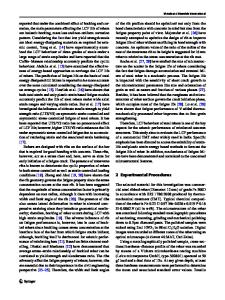Analysis of the Fatigue Failure of Rail Steel
- PDF / 2,927,002 Bytes
- 5 Pages / 612 x 792 pts (letter) Page_size
- 39 Downloads / 431 Views
LS
Analysis of the Fatigue Failure of Rail Steel S. A. Atroshenkoa, *, S. S. Mayerb, and V. I. Smirnovb a Institute b
of Mechanical Engineering, Russian Academy of Sciences, St. Petersburg, 199178 Russia Alexander the First St. Petersburg State University, St. Petersburg, 199034 Russia *e-mail: [email protected] Received April 21, 2020; revised April 21, 2020; accepted May 29, 2020
Abstract—The correlation between the mechanical properties of a material in microvolumes and the material under a load has been studied. A fractographic analysis is performed for the surface of fatigue failure of a railway rail with an internal cross crack. The correlation of the fractographic features with the material structure is discussed. A sample with an internal cross crack in the rail head had been withdrawn from service after severe cyclic loading in a turnout switch. For the metallographic study, the sample was subjected to a threepoint bending. Three regions with different characters of the material fracture have been revealed at the surface of the fracture. Keywords: rail, cross crack, fracture, fatigue failure DOI: 10.1134/S1063783420100029
1. INTRODUCTION
2. MATERIAL AND EXPERIMENTAL
The increase in the volume of cargo transportation and passengers and the motion intensity leads to an increase in the hazard of rail failure; thus the analysis of the failure and deformation changes in the rail structure after long-term service is a topical problem. A thermomechanical damage [1] appears when sliding wheels on a rail, when the rail is subjected to numerous cyclic loadings, and an increase in the number of the cycles leads to an increase in microstresses [2]. As a result, the rail surface is heated to a high temperature and then cooled, which leads to a change in the microstructure and the formation of microcracks that are the causes of initiation of cross fatigue cracks. These defects begin to form as an internal longitudinal crack forms from the rail surface. The longitudinal crack extension leads to the formation of a cross crack [3–5]. Such cracks are not detected by flaw detectors when they have small sizes and locate at large depths. When planning the operation of flaw detector units, it is important to know how fast a cross crack is extended under load and also the manner in which it propagates in the dependence on the surface area. To establish the rail failure cause, a 1.2-m-long sample with the crack in its middle was cut. Then, this sample was subjected to three-point bending by its head down up to its separation into parts. The fracture surface was subjected to a fractographic study. Then, a metallographic section with a thickness of ~1.5 cm was cut for metallographic study of the structure of the sample cross section.
We studied the fractured steel rail manufactured of R65 rail steel operating in a turnout switch. The properties and the elemental composition of the samples are determined by GOST R 51685–2013. The fraction of a tough component S (shear area in %) in the steel fracture was determined according to
Data Loading...











